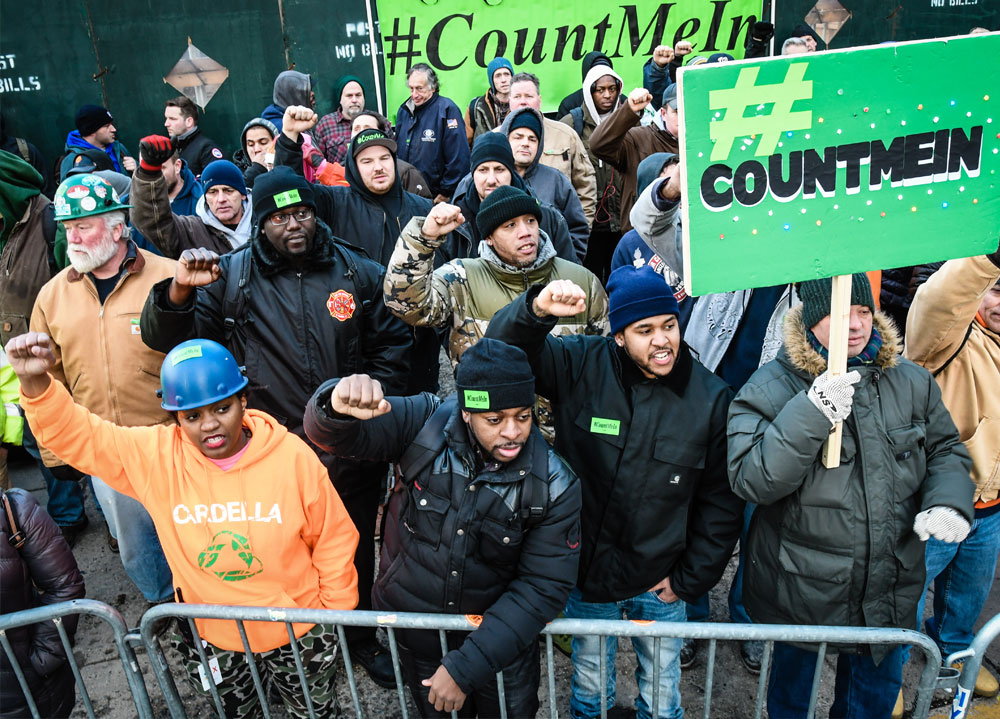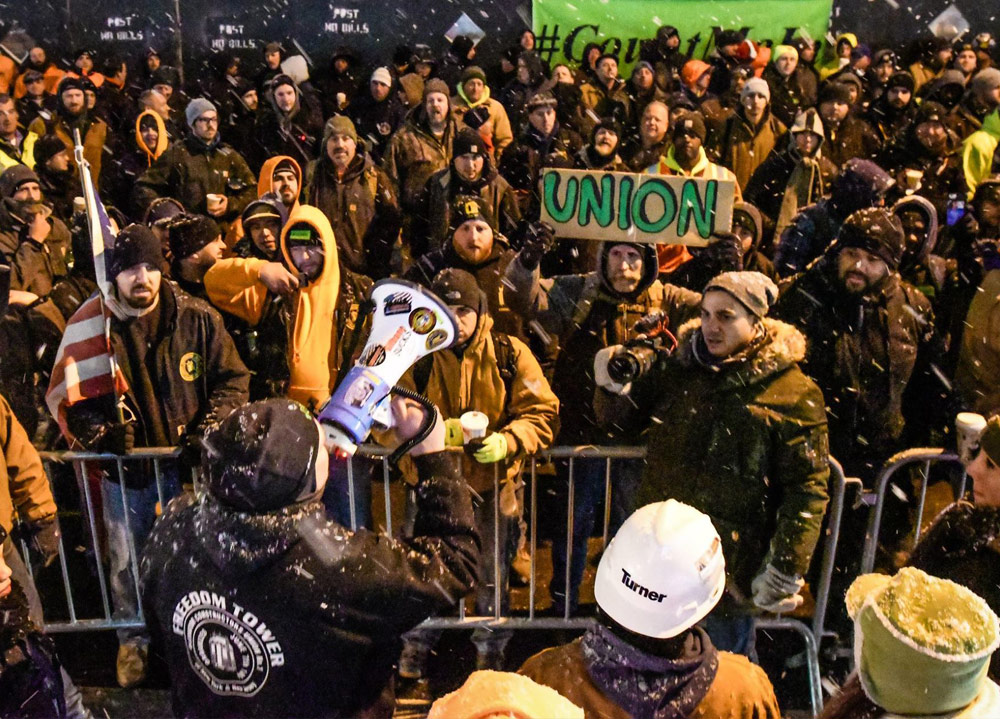Building Trades Nurture Union Solidarity Outside Hudson Yards
Looking at the gleaming Hudson Yards towers punching holes in the clouds over Manhattan’s West Side at W. 34th St. and 10th Avenue, members of New York City’s unionized Building Trades see their hold on the American Dream hanging in the balance.
“This is a small mirror on what’s happening across the country to the middle-class, Local 638 Steamfitter Brian Hunt told LaborPress at Tuesday’s #CountMeIn demonstration. “And this is a perfect example of the middle class coming together.”
The 36-year-old Long Island City resident has been on the job at Hudson Yards installing bulk piping and fire protection since 2014 — long enough to see those sparkling towers emerge.
But as the massive Hudson Yards Project — the largest private real estate development in United States history — enters Phase II, Hunt finds his future on the project, and the combined futures of his union brothers and sisters in the Building Trades, under threat.
Related Companies, the real estate development giant with a reported $50 billion in worldwide assets, has soured on the Project Labor Agreement it originally entered into with the Building & Construction Trades Council of Greater New York (BCTC) covering Phase I of the development.
Earlier this month, Hudson Yard Construction, LLC, went further , filing suit against the BCTC and its president, Gary LaBarbera, alleging a raft of corruption charges that also happen to perfectly mimic other well-worn attempts to malign the Labor Movement throughout history.
Unionized members of the Building Trades who have been rallying outside the Hudson Yards development on Tuesday afternoons and Thursday mornings as part of the #CountMeIn campaign, view Related’s actions as a naked attempt to build on the cheap utilizing a so-called “open shop” construction model that actually undermines good middle-class jobs and creates a race to the bottom that benefits no one but deep-pocketed developers.
Brooklynite Roberto Baez, a marble finisher with Local 7, said that he feels “blessed” to be part of organized labor, and that his union career has been “life changing.”
“The working class brings the money they earn back to New York City,” the 39-year-old married father of two continued. “It’s not like developers are going to provide discounts [on the money saved on labor]…they are not only cheating workers, but cheating the [economic] system.”
Despite the anger and frustration aimed at Related and its push for junk jobs that shortchange workers doing incredibly difficult and dangerous work, both Baez and Hunt expressed sympathy for poorly compensated non-union construction workers trying to scratch out a living within the so-called “open shop” system.
“I feel for them,” Hunt said. “They say, ‘I wish I could have what you have.’ It’s not the people [that are responsible for the race to the bottom] it’s the unscrupulous contractors.”
Baez said that his 16-years with the union has afforded him opportunities he never would have had as a non-union construction worker.
“Most non-union guys don’t know the importance of being a union member and putting money away for your future,” he said.
Indeed, the Economic Policy Institute [EPI] finds that, on average, union workers across different sectors earn over 13.2 percent more than their non-union counterparts — and that the decline of union density actually lowers wages for all non-union workers as well.
“It’s not just about the dollar amount; but benefits and respect,” Hunt added. “A lot of people try to disparage us. It’s very discouraging when you are being disrespected by the people hiring you.”
Erhan, a 28-year-old striking Charter/Spectrum worker who, along with two other striking co-workers, came out to this week’s #CountMeIn rally at W.34th Street and 10th Avenue in support of their union brothers and sisters in the Building Trades, took aim at the obscene compensation packages corporate heads including Charter/Spectrum CEO Tom Rutledge and Related Companies Founder Stephen Ross command.
Just last year alone, union-busting Tom Rutledge raked in a reported $98 million, while Ross — who also owns the Miami Dolphins — is reportedly worth $7.6 billion.
“I think it’s ridiculous that they are allowed to get away with this,” the striking Charter/Spectrum worker said. “I feel like whoever has the money does whatever they want.”
Hunt said that he has faith the Hudson Yards’ #CountMeIn campaign and the battle for good middle class jobs that enable workers to afford a home and provide for their families, will ultimately succeed.
If not, the young trade unionist lamented, New York City is in danger of “turning into China.”
This article was originally published on Labor Press.




